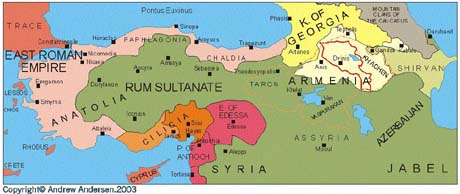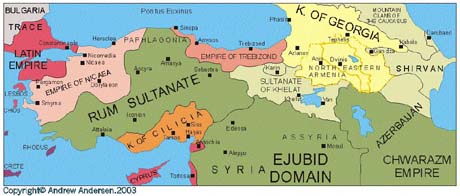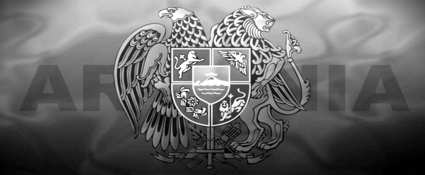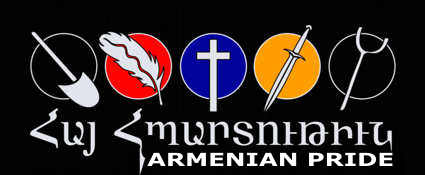Armenia
Medival Armenia and
Cilicia. Part II: 1096 - 1230
The year of 1096 signaled
the beginning of the Crusades and great changes in the
Middle East. The Crusaders established their own states in
Palestine and Syria and assisted East Roman (Byzantine)
empire to draw Seljuk Turks from some of her former Asian
provinces.
Cilicia (Lesser Armenia) became an
ally of the Crusaders. In their turn, the Crusaders crowned
Leo the 2nd King of Armenia in 1198 thus starting the
Rubenid dynasty in Cilicia. After the first Crusade
Cilicia significantly expanded to the South-West doubling
the size of the new Armenian Kingdom.
The Crusades
resulted in crushing the Turkish domination over some other
Armenian lands.
Cilicia and other
Armenian Lands in the Aftermath of the First Crusade
(1096-1099) and Georgian Reconquista: 1110-1124

 |
Muslim
(Turco-Arab) Possesions by 1125 |
 |
E. Rom. Empire by
1096 & Her Reconquests by 1125 |
 |
Crusader Srates
by 1100 |
 |
Georgia by 1121
&Her Conquests by 1124 |
 |
Georgia's
Tributaries by 1124 |
 |
Old Armenian
Lands |
 |
Cilicia by 1096 &
Her Conquests by 1125 |
 |
Modern Armenia |
In 1097 the Crusaders
under Baldwin took the fortified city of Edessa and
established the Earldom of Edessa that survived until 1144
covering a sizeable, predominantly Armenian-inhabited
territory.
The political
development of the South Caucasus was marked by an
impressive Georgian reconquista. Under the leadership of
King David of the Bagratid dynasty, Georgians won a number
of wars against the Turco-Arab powers of the area and by
1124 liberated half of the old Armenian lands, so that their
King David the Builder also became the King of both
Georgians and Armenians thus uniting the two peoples under
one Crown.
Cilicia and Other
Armenian Lands in the Aftermath of the Fourth Crusade and
the Fall of East Roman Empire (1204-1235)

 |
Muslim
(Turco-Arab) Possesions by 1235 |
 |
Byzantie
(E.Roman) Successor States |
 |
Crusader States |
 |
Kingdom of
Georgia & Her Tributaries by 1235 |
 |
Venetian
Possesions after 1204 |
 |
Armenian Domains
of Georgia Governed by the Zakharids |
 |
Armenian Kingdom
in Cilicia |
 |
Modern Armenia |
The second half of the
12th century was marked by the strife between the
crusaders and East Roman Empire (Byzantium) resulting in the
collapse of the latter one and the establishment of the
Latin Empire in 1204. At the same time, the crusaders
suffered serious defeats in Palestine and Syria losing most
of their previously conquered territories. However, the
Kingdom of Cilicia survived and kept her borders unchanged.
In the South
Caucasus the Kingdom of Georgia expanded further under Queen
Tamar and King George the Beautiful. Armenian provinces of
Georgia were put under the hereditary governance of the
princely family of Zakharyan. In South-Western half of
Armenia was put under Georgian protectorate and re-organized
into the Sultanate of Khelat and Emirate of Karin
(Erzeroum)
Copyright © 1996-2005
Atlas of Conflicts, Andrew Andersen. All rights reserved. |

